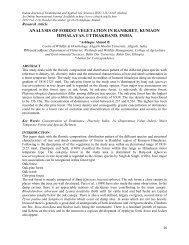in vitro propagation of rhododendron niveum hook f (state ... - CIBTech
in vitro propagation of rhododendron niveum hook f (state ... - CIBTech
in vitro propagation of rhododendron niveum hook f (state ... - CIBTech
You also want an ePaper? Increase the reach of your titles
YUMPU automatically turns print PDFs into web optimized ePapers that Google loves.
Cibtech Journal <strong>of</strong> Biotechnology ISSN: 2319-3859 (Onl<strong>in</strong>e)<br />
An Onl<strong>in</strong>e International Journal Available at http://www.cibtech.org/cjb.htm<br />
2013 Vol. 2 (1) January-March., pp.53-60/S<strong>in</strong>gh et al.<br />
Research Article<br />
issue <strong>in</strong> the Sikkim Himalaya is almost non existent. Rhododendron <strong>niveum</strong> Hook f. (Ericaceae) locally<br />
known as Hiupatae gurans (snow leaf), endemic to Sikkim (also the <strong>state</strong> tree <strong>of</strong> Sikkim) more or less<br />
localized with<strong>in</strong> 3500-4500 m elevations limited to a microniche at a place called Yakchey <strong>in</strong> northern<br />
Sikkim. The species is much less <strong>in</strong> number and at the verge <strong>of</strong> ext<strong>in</strong>ction it needs high-priority<br />
conservation measures (S<strong>in</strong>gh, 2009). The regeneration status <strong>in</strong> the form <strong>of</strong> available seedl<strong>in</strong>gs/sapl<strong>in</strong>gs<br />
is very poor for many <strong>of</strong> the Rhododendrons (Krishna et al., 2002; S<strong>in</strong>gh et al., 2003; S<strong>in</strong>gh, 2008;<br />
Kumar et al., 2005; Paul et al., 2005; S<strong>in</strong>gh et al., 2008; S<strong>in</strong>gh et al., 2008a). Tissue culture is the only<br />
method to ma<strong>in</strong>ta<strong>in</strong> and propagate the genetically identical clone rapidly <strong>in</strong> large numbers and <strong>in</strong> long<br />
term culture. Hence, <strong>in</strong> <strong>vitro</strong> conservation seems to be an appropriate option for the protection <strong>of</strong> R.<br />
<strong>niveum</strong> out <strong>of</strong> its natural habitat.In this communication, the authors report a high frequency regeneration<br />
system for the first time from cotyledonary node explant <strong>of</strong> R. <strong>niveum</strong> us<strong>in</strong>g 2ip alone or <strong>in</strong> comb<strong>in</strong>ation<br />
with IAA and successful establishment <strong>of</strong> micropropagated plant to field conditions.<br />
MATERIALS AND METHODS<br />
Seed vigour test<br />
Seed vigour was tested with the tetrazolium test (Agrawal et al., 1973). Halved seeds were treated <strong>in</strong><br />
tetrazolium solution (TTC, 0.1%) for 2 h at room temperature and red-sta<strong>in</strong><strong>in</strong>g embryos were evaluated as<br />
alive.<br />
Plant material<br />
Seeds were collected <strong>in</strong> October 2008 <strong>in</strong> Yakchey <strong>in</strong> North Sikkim (Longitude 27 o 43’ North, and<br />
Latitude 88 o 45’ East with an elevation 3500 m amsl). Immediately after collection, capsule were dried at<br />
room temperature for 1 week and then stored <strong>in</strong> small plastic bags at 4 o C.<br />
Seed sterilization and culture conditions<br />
Seeds were thoroughly washed with a detergent (Tween -80; 1.0%, v/v; 20 m<strong>in</strong>), and surface sterilized <strong>in</strong><br />
0.15%; w/v mercuric chloride (HgCl 2 ) for 3 m<strong>in</strong>, subsequently washed 5 times <strong>in</strong> sterile distilled water <strong>in</strong><br />
a lam<strong>in</strong>ar flow hood and implanted on hormone free MS medium (Murashige and Skoog, 1962)<br />
supplemented with 3% sucrose and 0.8% (w/v) agar <strong>in</strong> culture tubes for germ<strong>in</strong>ation. The cultures were<br />
kept at 24 o C ± 1 o C and 16/8 light/dark cycle with irradiance <strong>of</strong> 60 mol m -2 s -1 provided by cool white<br />
fluorescent tube. R. <strong>niveum</strong> seeds germ<strong>in</strong>ated with<strong>in</strong> 15-20 days <strong>of</strong> <strong>in</strong>oculation on hormone free MS<br />
medium (Figure 1A).<br />
Multiple shoot formation<br />
The nodal segment explants (1.0-1.5 cm <strong>in</strong> length) from aseptic seedl<strong>in</strong>gs <strong>of</strong> R. <strong>niveum</strong> were cultured on<br />
the AM medium (Anderson, 1984) supplemented with different Cytok<strong>in</strong><strong>in</strong>s, 6-benzyladen<strong>in</strong>e (BA); 2-<br />
isopentyladen<strong>in</strong>e (2iP) or K<strong>in</strong>et<strong>in</strong> (KIN) at different concentrations (0.5, 1.0, 2.5, 5.0, 7.0, 10.0 mg/l)<br />
along with additives (100 mg/l PVP, 100 mg/l ascorbic acid and 10 mg/l citric acid). The medium was<br />
gelled with 0.3 % phytagel adjusted to pH 5.8 us<strong>in</strong>g 1N NaOH before autoclav<strong>in</strong>g at 121 o C at 1.06 kgcm -2<br />
for 15 m<strong>in</strong>. All the culture ma<strong>in</strong>ta<strong>in</strong>ed at 17±1 o C under 16 h photoperiod with a photosynthetic photon<br />
flux density (PPFD) <strong>of</strong> 60 mol m -2 s -1 provided by cool white fluorescent lamp (Philips, India Ltd.) and<br />
60% relative humidity.<br />
In addition, the effects <strong>of</strong> these, the optimal concentration <strong>of</strong> Cytok<strong>in</strong><strong>in</strong> (2iP) was used <strong>in</strong> comb<strong>in</strong>ation<br />
with 0.1 mg/l Indole-3-acetic acid (IAA). Seven shoots per glass flask (250 mL) were cultured <strong>in</strong> 60mL<br />
<strong>of</strong> medium. In all treatments, the frequency <strong>of</strong> shoot <strong>in</strong>duction, number <strong>of</strong> shoots and mean shoot length<br />
and callus formation were recorded after 8 weeks <strong>of</strong> culture. All cultures were subcultured to a fresh<br />
medium after every 4 week <strong>in</strong>tervals.<br />
In <strong>vitro</strong> root<strong>in</strong>g and acclimatization<br />
The elongated shoots (4-5 cm) were excised <strong>in</strong>dividually and transferred to liquid AM supplemented with<br />
NAA or IBA (0.05, 0.1, 0.2, 0.3, 0.5, 1.0 mg/l) on filter paper bridge for root<strong>in</strong>g. The results <strong>of</strong> the<br />
root<strong>in</strong>g experiments were expressed as percentages. In cultures, where the shoots were <strong>in</strong>oculated on<br />
54
















